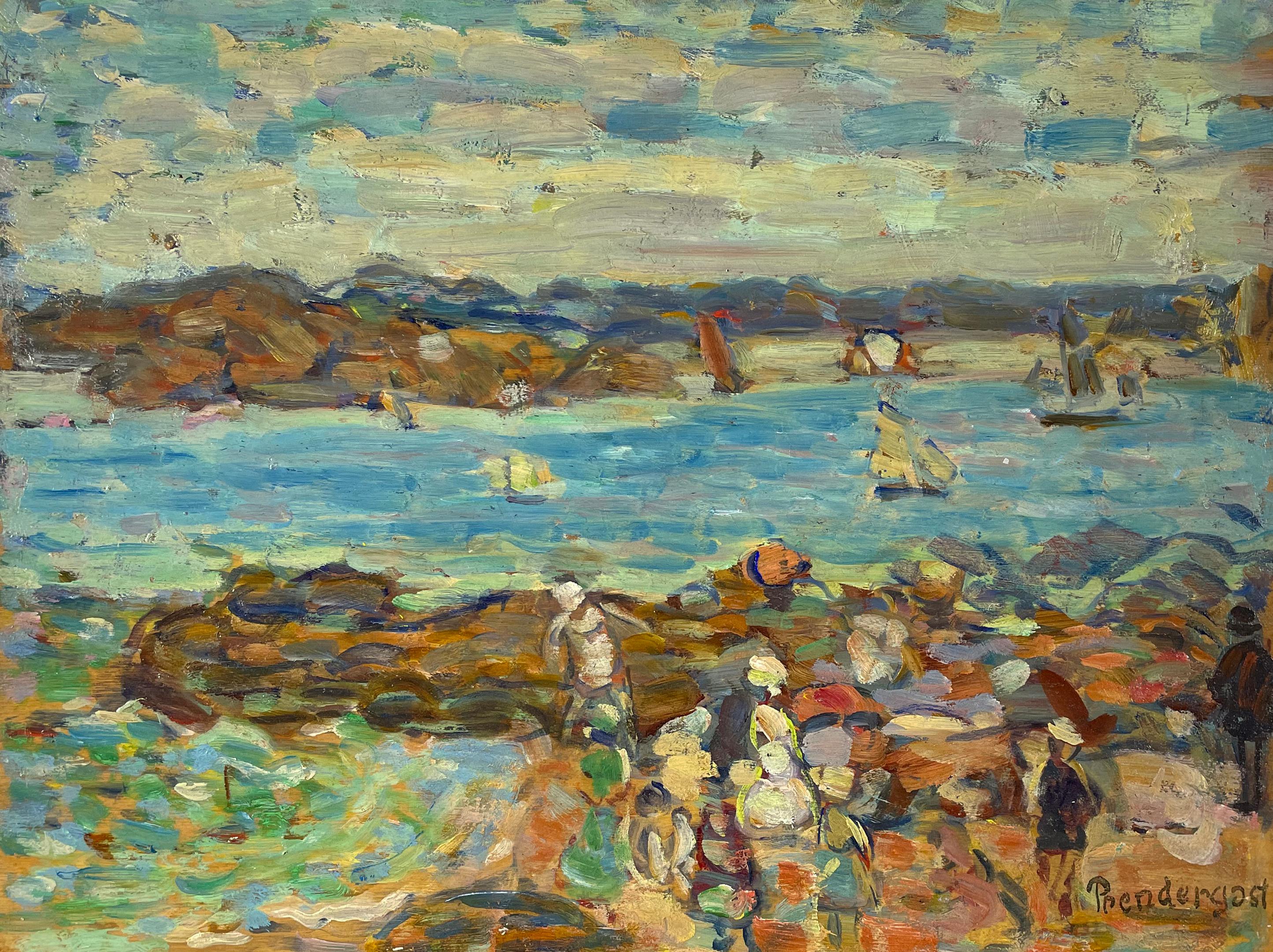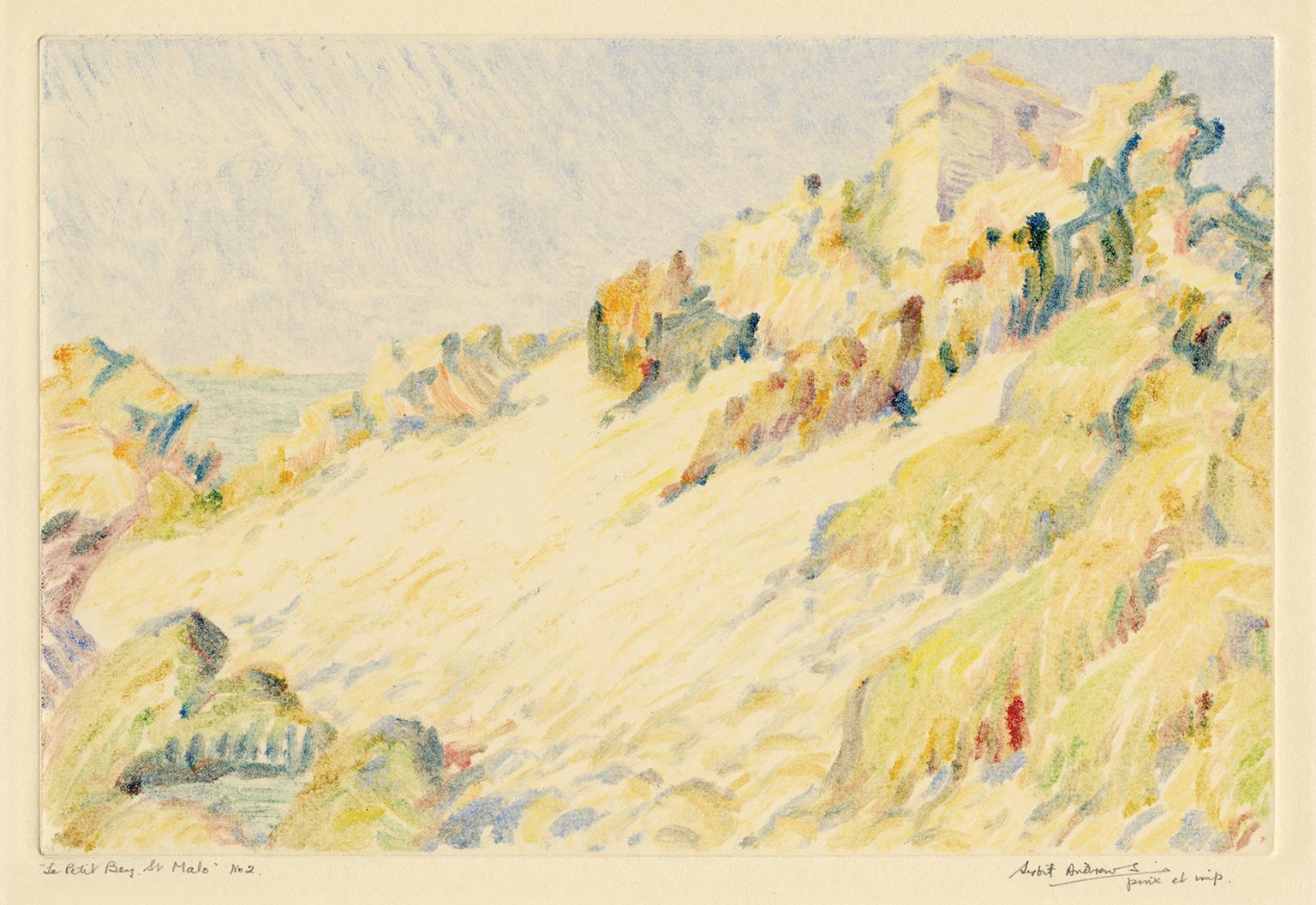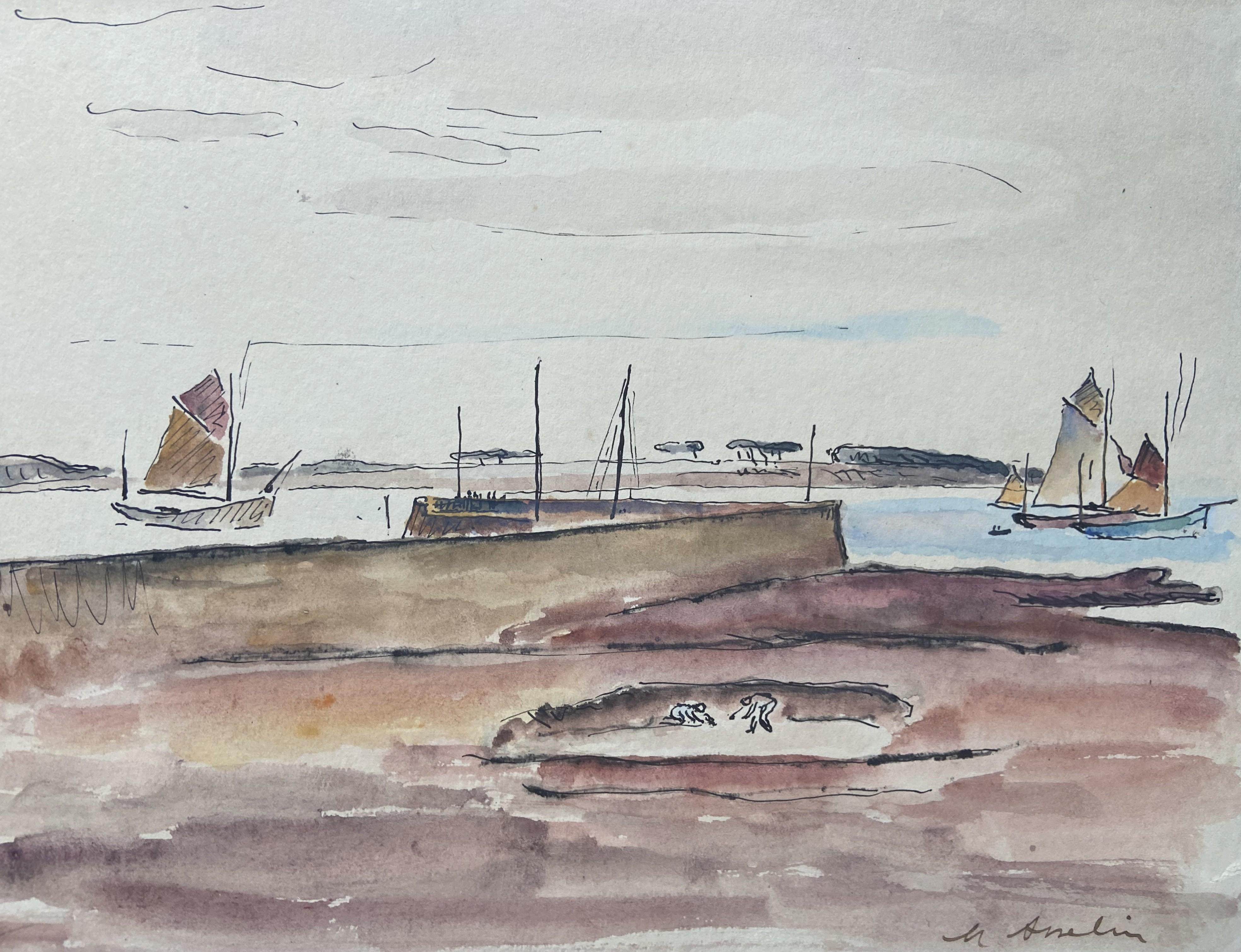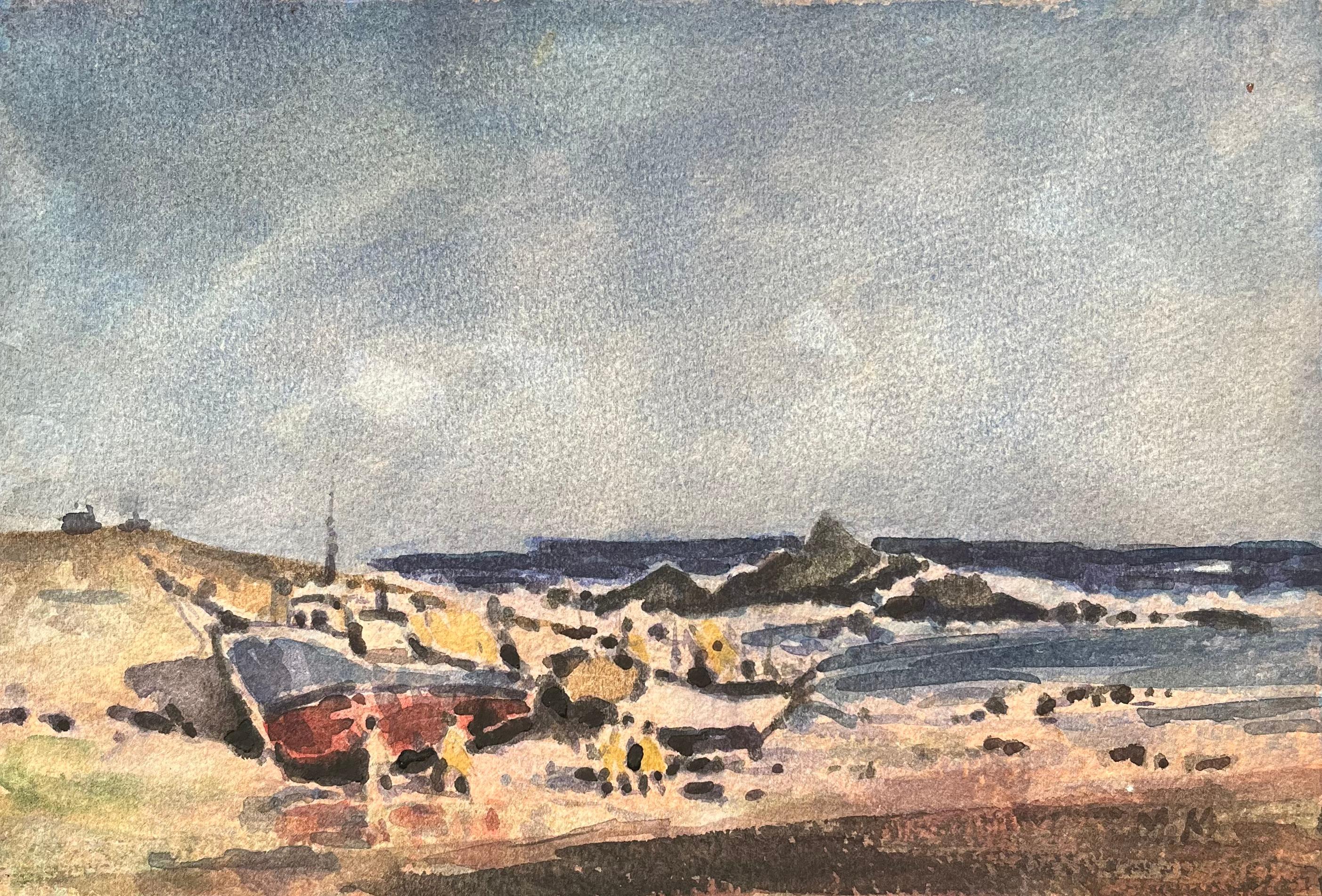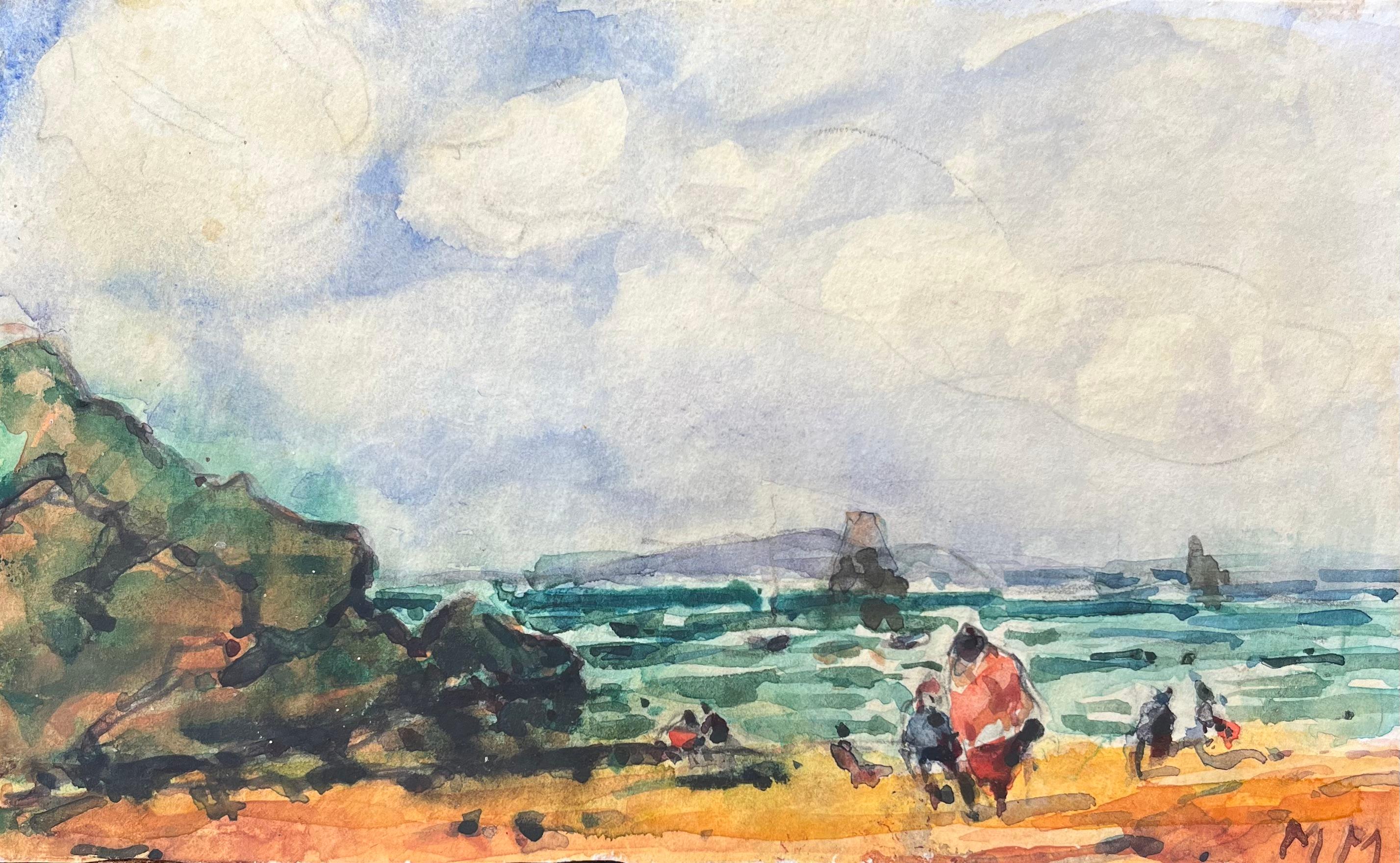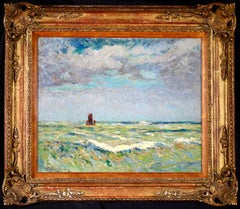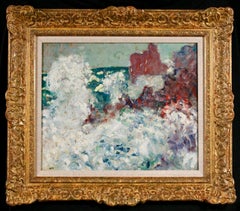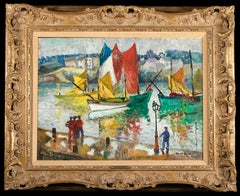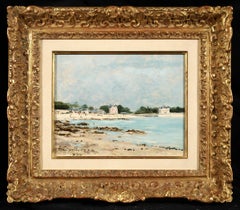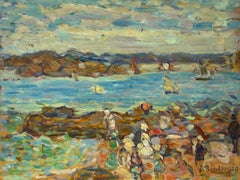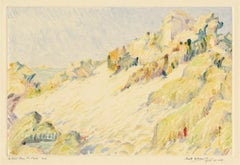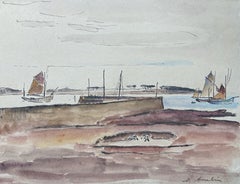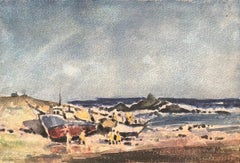Items Similar to Saint Malo - Post Impressionist Seascape Watercolor by Maurice Prendergast
Want more images or videos?
Request additional images or videos from the seller
1 of 15
Maurice Brazil PrendergastSaint Malo - Post Impressionist Seascape Watercolor by Maurice Prendergast1907
1907
$63,194.85
£46,665
€54,689.90
CA$87,148.42
A$97,907.34
CHF 51,156.74
MX$1,195,004.94
NOK 649,541.15
SEK 611,406.16
DKK 408,116.40
About the Item
Signed watercolour on paper landscape by American post impressionist painter Maurice Brazil Prendergast. The work depicts children playing on the beach in Saint Malo, France as boats sail in the blue sea and white clouds role through the sky overhead. This work has remained in the Prendergast family for 3 generations and depicts a rare view of Saint-Malo executed during Prendergast's visit to the french coastal town in 1907
Signature:
Signed lower left
Dimensions:
Framed: 21"x22"
Unframed: 13'x14"
Proveance:
The collection of Charles Prendergast (1863-1948)
The collection of Eugénie Prendergast-Van Kemmel (1895-1994) -wife and inheritor of the estate of Charles Prendergast
The collection of Henri Van Kemmel (Lille, 1903-1963) - cousin of Eugenie Prendergast
- Madame Henri Van Kemmel
Maurice Prendergast came with his family to Boston in 1861. Working in a textile store, Maurice Prendergast was at first self-taught in painting, making souvenir cards and shop signs. He went to Britain in 1886, then to Paris in 1891 and registered at the Académie Julian with Jean-Paul Laurens, Benjamin-Constant, and Charles Blanc as teachers, working also with Gustave Courtois at the Académie Colarossi. More importantly he saw the Impressionists’ paintings and the Nabis at the Galerie Durand-Ruel. He returned to the United States in 1895, settling in Winchester (Massachusetts) and went frequently to New York. In 1898 he again went to Europe where he stayed until 1900, visiting Paris, Florence, Siena, Rome, Capri, and Venice, where he spent six months. Between 1907 and the beginning of World War I he went again four times to Europe but never returned there after the war. In New York where he finally settled, with William Glackens, Robert Henri, and John Sloan among others, Prendergast was one of the members ofThe Eight, gathered by Robert Henri to counter the pervading academicism. The group exhibited in 1908 at the Macbeth Galleries and took part in the Armory Show of 1913. After that Prendergast did not exhibit again with the group. In 1914 he left Boston definitively for New York.
Prendergast was in his thirties before he began to devote himself to painting. In his late beginnings he painted in the open air as the Impressionists did, mainly in watercolours with clear brushstrokes and an elegant virtuosity recalling his then admiration for James Whistler and Claude Monet. Between 1892 and 1905 he carried out two hundred monotypes, a technique of which he was the undisputed master in America at that time and which expressed the influence of Japanisme. During his stays in France he painted views of Paris, but also Brittany and Normandy. In this period, in 1896, he was chosen to illustrate My Lady Nicotine by Matthew Barrie. During his third stay in Europe, from 1898 to 1900, he painted in Paris, at Saint-Malo, and mainly in Venice, where, influenced by Vittore Carpaccio he introduced brightly coloured banners into his animated compositions. In oils he painted slowly, touching up his paintings by superimposed brushstrokes, sometimes over several years. He chose to use the divided stroke in an early period, a technique which had similarities with Post-Impressionism. After his travels in Europe and his discovery of Paul Cézanne, he evolved in the direction of the neo-Impressionism of Georges Seurat, placing little dots of colours with a knife, then of the Nabis and even later Fauvism, painting large brushed surfaces in bright colours. After 1899, his Ponte della Paglia in Venice freed itself from strict divisionism, adopting the dense composition in vertically superimposed planes of the Nabis. Like the members of the group of eight, he took his subjects from the daily life of ordinary people, in scenes in the parks or on the beaches of New England, picnics or sometimes circuses. Nevertheless the happy vision that he had of the world separated him strongly from the evolution that led his companions to paint the most miserable and populous milieus, which gave them the name of The Ashcan School. His compositions are arranged in surfaces superimposed vertically, without depth; while the Impressionists and Post-Impressionists were influenced by the layout of Japanese prints, Prendergast was inspired more by Persian miniatures. The decorative elements and the build-up of characters in crowds are placed frontally, like garlands on a tapestry, particularly as he seeks a texture effect, covered entirely by the subject without any empty spaces. His attraction to colours caused him to research all the motifs that he introduced into these compositions: umbrellas, parasols, balloons, draperies. In 1911–1912, he experimented with pastel and treated new subjects, nudes and still-lifes. After 1913, in sympathy with the Symbolists, he put nude figures and everyday characters side by side in the same composition. In his last years, and above all in the watercolours, he discarded the divided stroke and applied larger brushstrokes, similar to the technique of Henri Matisse. Fidelity to the leisurely settings and elegant grooming of the period gave his works, apart from their artistic value, a charming sociological aspect. Singular, almost marginal in his time, his paintings stand out by the density of their composition, in form and colouring, characterised by the accumulation of detail, minutiae of scenery, the serried ranks of people that animate them, the chromatic polyphony of elegance, umbrellas, parasols, and flags. He is a complete painter, particularly generous, who would never be happy to provide only samples of his art. Following Whistler and Mary Cassatt, Maurice Prendergast is one of the most interesting and original Post-Impressionist American painters, and perhaps marks exactly the boundary between the 19th and the 20th centuries.
He was considered to be an ‘old master’ from 1920 on, and his works appeared in very many exhibitions of modern American painting. He had his first solo exhibition in 1897 at the Chase Gallery of Boston, where his works were noticed by Madame Montgomery Sears, who made a collection, taking the advice of Mary Cassatt. In 1915 six paintings and watercolours exhibited at the Carroll Gallery of New York established his success and drew the great collectors to him, among whom were Albert Barnes and John Quinn.
Group Exhibitions
1974, Ten Americans, Andrew Crispo Gallery, New York
1976, Art of Impulse and Color, University of Maryland Art Gallery, College Park (Maryland)
1982, American Impressionists, Smithsonian Institution, Washington, DC (also presented at the Musée du Petit Palais, Paris)
1999, Town and Country: American Artists, 1870–1920 (Ville et campagne: les artistes américains, 1870–1920), Musée d’Art Américain, Giverny
2002, Japonisme in America: Works on Paper, 1880–1930 (Le Japonisme en Amérique: œuvres sur papier, 1880–1930), Musée d’Art Américain/Terra Foundation for the Arts, Giverny
2007, American Impressionists: Painters of Light and the Modern Landscape, Phillips Collection, Washington, DC
2008, Coming of Age: American Art 1850–1950, Paintings from the Addison Gallery of American Art, Massachusetts, Dulwich Picture Gallery, London
2008, Portrait of a Lady: Paintings and Photographs of American Women in France 1870–1915, Musée des Beaux-Arts, Bordeaux
Solo Exhibitions
1934, Maurice Prendergast Memorial Exhibition, Whitney Museum of American Art, New York
1938, Retrospective Exhibition of the Work of Maurice and Charles Prendergast, Addison Gallery of American Art, Andover, MA
1960, Maurice Prendergast, 1859–1924, Museum of Fine Arts, Boston
1990, Art Institute of Chicago
2009, Prendergast in Italy, Peggy Guggenheim Collection, Venice
Museum and Gallery Holdings
Andover, MA (Addison Gal. of American Art): At the Shore, St. Malo No. 1 and 2 (c. 1907, watercolour and graphite on wove paper, 2 works); Along the Cove (1910–1913, oil on canvas); seven sketches of Paris (1893, oil on wood)
Chicago (AI): In the Park (1918–1919)
Chicago (Terra Foundation for American Art Collection): Festa del redentore (c. 1899, monotype); The Opera Cloak (1895–1897, monotype); Evening, South Boston Pier (1895–1897, monotype); Evening on a Pleasure Boat (1895–1897, oil on canvas); Children at Play (c. 1895); At the Seashore (1895, monotype); Early Evening, Paris (c. 1892, monotype); Woman on the Boulevard (1890–1894, oil on canvas); The Luxembourg Garden, Paris (1892–1894, oil on canvas); Franklin Park, Boston (c. 1895, watercolour); Monte Pincio, Rome (1898–1899, watercolour)
Cleveland (MA): A Bridge in Venice (1899); May Day, Central Park (1901)
Detroit (IA): Promenade (1914–1915, oil on canvas)
London (Courtauld Institute of Art): Festival Night, Venice (1898–1899, gouache and brush on paper)
Los Angeles (County MA): Cove, Maine (c. 1907–1910, oil on canvas)
New York (Eugenie Prendergast Found.): Vision (1912); Beach at Gloucester (1916, watercolour, other works)
New York (Metropolitan MA): Piazza di San Marco (1898–1899, watercolour and graphite on off-white wove paper); Central Park (c. 1914–1915, oil on canvas)
New York (MoMA): Venice, the Lagoon (1898–1900); Orange Market (1900, monotype with pencil additions); The Rehearsal (1900, monotype)
New York (Whitney Mus. of American Art): Dieppe (1892); Central Park (1901, watercolour, and important collection); The Promenade (1913, oil on canvas)
Ottawa (NG of Canada): The Picnic (c. 1914–1915, oil on canvas)
Washington, DC (NGA): The Mall, Central Park (1900, watercolour and graphite on wove paper); Salem Cove (1916, oil on canvas)
Washington, DC (Phillips Collection): Ponte della Paglia (1899, oil on canvas)
Worcester, MA (AM): Venice (1901, watercolour); Low Tide, Beachmont (c. 1902–1904, watercolour); Notre-Dame (1910, watercolour and gouache); New England Shore (oil/panel)
- Creator:Maurice Brazil Prendergast (1858 - 1924, American)
- Creation Year:1907
- Dimensions:Height: 21 in (53.34 cm)Width: 22 in (55.88 cm)
- Medium:
- Movement & Style:
- Period:
- Condition:Very good condition.
- Gallery Location:Marlow, GB
- Reference Number:Seller: LFA04781stDibs: LU415316607422
About the Seller
5.0
Gold Seller
Premium sellers maintaining a 4.3+ rating and 24-hour response times
Established in 2001
1stDibs seller since 2016
706 sales on 1stDibs
Typical response time: <1 hour
- ShippingRetrieving quote...Shipping from: Marlow, United Kingdom
- Return Policy
Authenticity Guarantee
In the unlikely event there’s an issue with an item’s authenticity, contact us within 1 year for a full refund. DetailsMoney-Back Guarantee
If your item is not as described, is damaged in transit, or does not arrive, contact us within 7 days for a full refund. Details24-Hour Cancellation
You have a 24-hour grace period in which to reconsider your purchase, with no questions asked.Vetted Professional Sellers
Our world-class sellers must adhere to strict standards for service and quality, maintaining the integrity of our listings.Price-Match Guarantee
If you find that a seller listed the same item for a lower price elsewhere, we’ll match it.Trusted Global Delivery
Our best-in-class carrier network provides specialized shipping options worldwide, including custom delivery.More From This Seller
View AllGrosse Mer - Etretat - Impressionist Seascape Landscape Oil by Maxime Maufra
By Maxime Maufra
Located in Marlow, Buckinghamshire
Impressionist oil on canvas seascape painting circa 1895 by French artist Maxime Maufra. This stunning work depicts a sailing boat on a vast ocean. The choppy water is painted in greens and blues. The white clouds rolling across the blue sky are beautifully shaded in purple tones.
Signature:
Signed lower left and titled on original label verso
Dimensions:
Framed: 22"x25"
Unframed: 15"x18"
Provenance:
This work is included in the catalogue raisonne of Maxime Maufra under reference 284
Durand-Ruel, Paris (acquired directly from the artist on 5 April 1895)
Durand-Ruel Galleries, New York (acquired from the above in 1895)
Marlborough Fine Arts, Ltd., London (acquired after 1949)
Dr. Renate Davis, London (acquired from the above)
Lyon & Turnbull London, 28 November 2013, lot 111 (consigned by the above)
Private Collection, New York (acquired from the above sale)
Sotheby's New York, 15 November 2017, lot 101 (consigned by the above)
Maufra spent several years in England, notably in Liverpool, with his father, who wanted him to become a tradesman. He decided to take up painting instead and returned to France in 1883, attracting the attention of Octave Mirbeau in his very first exhibition, and subsequently being noticed by Frantz Jourdain in 1894 and Fontenais in 1901. In 1886, he successfully exhibited two seascapes at the Salon, following which he visited Brittany in 1890, making the acquaintance of Gauguin and Sérusier in Pont-Aven; he collaborated with them on the decoration of the Pouldu Inn in 1894. He maintained his acquaintance with the Nabis group artists Henry Moret and Gustave Loiseau. He travelled in l'Isère, Belgium, and Algeria (1913), as well as Paris, the Ile de France, Brittany and Normandy. From 1895, the Galerie Durand-Ruel assured the success of his work.
Maufra settled in Montmartre for about ten years during which he painted the old quarters of Paris, often around the church of St Séverin. He then turned to Brittany and Normandy for inspiration in keeping with a resolve to paint only from nature, his seascapes in particular finding favour. The influence of the Nabis on his work remains limited except in the 'synthetic' organisation of the composition. He was an admirer of Sisley and Pissarro, whose influence can be seen in his paintings. Maufra, like Valtat, went to some extent beyond Impressionism to become a forerunner of Fauvism in his use of colour.
An important retrospective exhibition of Maufra's work, prefaced by René Domergue, was organised in Paris around 1950. In 2001, his work was represented in the exhibition Painters and the Sarthe Region ( Les Peintres et la Sarthe) held at the Musée de la Reine Bérengère (for the 19th century) and the Abbaye de l'Épau (for the 20th century) at Le Mans. In 2003, his work appeared in the group exhibition Brittany, Land of Painters ( Bretagne, Terre des Peintres) at the Musée des Beaux-Arts in Vannes.
Museum and Gallery Holdings:
Bergues: Seascapes
Boston: Dusk in Douarnenez; Departure of Fishing Boats
Buffalo: Transport Quittant Le Havre
Chicago: Douarnenez the Town of Light
Cholet: Flood
Cincinnati (AM): The Coast, Bay of Douarnenez (Vue de Douarnenez) (painting)
Helsinki: St-Guénolé
Le Havre: Moonrise in Brittany
Manchester: Springtime in Lavardin
Montpellier: Hills of Morgat
Mulhouse: Low Tide
Nantes (MBA): La Prairie d'Amont (1888, oil on canvas); Pointe du Raz; Heavy Swell; The Loir Dam in Poncé (oil on canvas)
Paris (Mus. d'Orsay): Brittany Landscape...
Category
1890s Impressionist Landscape Paintings
Materials
Canvas, Oil
Les Vagues a Agay - Fauvist Seascape Oil Painting by Louis Valtat
By Louis Valtat
Located in Marlow, Buckinghamshire
Signed fauvist oil on panel seascape circa 1900 by French painter Louis Valtat. This stunning piece depicts a view of large waves crashing against large rocks at Agay on the Cote d'A...
Category
Early 1900s Fauvist Landscape Paintings
Materials
Oil, Panel
Harbour at St Ives - Impressionist Figures Seascape Oil by Richard Hayley Lever
By Richard Hayley Lever
Located in Marlow, Buckinghamshire
Signed figures in landscape oil on board by Australian-American impressionist painter Richard Hayley Lever. The work depicts brightly coloured sailing boats in the harbour of St Ives...
Category
Early 1900s Impressionist Figurative Paintings
Materials
Oil, Canvas
Le plage de Morgat - Impressionist Seascape Landscape Oil by Maxime Maufra
By Maxime Maufra
Located in Marlow, Buckinghamshire
Signed and dated impressionist oil on panel seascape painting by French painter Maxime Maufra. This stunning work depicts the beach at Morgat in Brittany, northwest France. The cryst...
Category
1880s Impressionist Landscape Paintings
Materials
Oil, Panel
Port of Le Havre & Sainte-Adrese- Post Impressionist Seascape Oil - Othon Friesz
By Achille-Émile Othon Friesz
Located in Marlow, Buckinghamshire
Signed and dated oil on canvas seascape by French post impressionist painter Achille-Emile Othon Friesz. The piece depicts a view of Le Havre, a port city in Normandy, France, locate...
Category
1920s Post-Impressionist Landscape Paintings
Materials
Canvas, Oil
Plage a Belle Ile - Post Impressionist Landscape Oil by Georges D'Espagnat
By Georges d'Espagnat
Located in Marlow, Buckinghamshire
Signed post impressionist landscape oil on panel by popular French painter Georges D'Espagnat. The piece depicts the beach at Belle Ile, an island off the coast of Brittany in France, at sunset. An exceptional early painting by D'Espagnat which shows the precursor influence of Fauvism which was to dominate his paintings in the following few years.
Signature:
Signed lower right
Dimensions:
Framed: 23"x26"
Unframed: 15"x18"
Provenance:
Private French collection
A certificate of authenticity from Mr. Jean-Dominique Jacquemond is available upon request.
This work will be included in the catalogue raisonne of Georges D'Espagnat under preparation by Mr. Jacquemond
From the beginning of his career, it was a constant concern of Georges d'Espagnet to assert his originality. His studies at the École des Arts Décoratifs, Paris, did not last very long, for he wanted immediate independence and decided to follow courses in the private academies of Montparnasse. In about 1900, he became acquainted with Maurice Denis, Bonnard and Vuillard, and his collaboration with Denis led to a renewal of religious art in France.
In 1903, d'Espagnet was one of the founders of the Salon d'Automne, and was appointed professor in charge of studios at the École des Beaux-Arts, Paris, in 1934. He illustrated a number of books: Rémy de Gourmont's Evil Prayers ( Oraisons mauvaises) (1896), The Saints of Paradise ( Les Saintes du paradis) (1898), Simone (1907), Sistine ( Sixtine) (1922); Alphonse Daudet's The Immortal ( L'Immortel) (1930); André Gide's The Pastoral Symphony ( La Symphonie pastorale); Francis Jammes' Clearings in the Sky ( Chairières dans le ciel) (1948).
D'Espagnet belongs to the group of artists who made the Courrier Français so successful. The drawings of his which are published in it are strongly expressive and some bear comparison with the designs of the great Renaissance masters. He also contributed to L'Image. He often placed cheerful nudes in a landscape, reminding us that, though he moved away from the Fauves, he retained their freedom of colour and arabesque. He painted many portraits, including those of Albert André, André Barbier, Victor Boucher, Déodat de Séverac, Albert Marque, André Marty and Albert Roussel. He also painted mural decorations, including a wall for the Palais de la Découverte (1937), the ceiling of the Victor Hugo Room in the Palais du Luxembourg (1939), a decorative panel for the Palais de Justice, Toulouse (1941) and interior decorations for private houses. His landscapes are Impressionist in inspiration, and work for a certain sobriety, an intimacy, both in their composition - one, two or three sketched figures and large open spaces - and in the choice of colours and treatment with the special hazy brushstroke that marks his style.
D'Espagnet took part in a number of annual Parisian exhibitions, including the Salon des Indépendants, the Salon de la Société Nationale des Beaux-Arts, the Salon d'Automne (from 1903 to 1949, except in special circumstances), the Salon de la Libre Ésthétique, Brussels (1899, 1901), the Berlin Secessionists (1940). He also exhibited at the first Salon de la Société de la Gravure sur Bois. Among other exhibitions were 1912, A Century of French Art ( Centenaire de l'art français), St Petersburg; 1916, Kunstverein, Winterthur; 1918, 1926, Galerie M. Bertheim, Paris; 1930, Contemporary French Art...
Category
Early 1900s Post-Impressionist Landscape Paintings
Materials
Oil, Panel
You May Also Like
Study St. Malo
Located in Bryn Mawr, PA
Provenance
The Artist;
Charles Prendergast (acquired from the above in 1924);
Mrs. Charles Prendergast (thence by descent from theabove in 1948);
Kraushaar Galleries, New York;
Mr...
Category
Early 1900s Post-Impressionist Landscape Paintings
Materials
Oil, Wood Panel
'Le Petit Bay, St. Malo' — 1920s British Impressionism
By Sybil Andrews
Located in Myrtle Beach, SC
Sybil Andrews, 'Le Petit Bay, St. Malo', color monotype, c. 1925; edition 3, print 2. Signed 'Sybil Andrews pinx et imp' annotated 'No 2' and titled in pencil. A superb, luminous imp...
Category
1920s Post-Impressionist Landscape Prints
Materials
Monotype
Maurice Asselin (1882-1947) A Seascape, Brittany, watercolor signed
By Maurice Asselin
Located in Paris, FR
Maurice Asselin (1882-1947)
A Seascape, Brittany,
signed lower right
watercolor on paper
19.7 x 25.2 cm
Framed : 35 x 40.5 cm
Maurice Asselin was particularly attached to Britta...
Category
1920s Post-Impressionist Landscape Drawings and Watercolors
Materials
Watercolor
French Impressionist Watercolor of Coastal Scene with Fishing Boats and Figures
Located in Cirencester, Gloucestershire
Title: French Impressionist Watercolor of Coastal Scene with Fishing Boats and Figures
By Maurice Mazeilie (French 1924-2021)
Medium: Watercolor on paper, unframed
Size: 7.5 x 11 inc...
Category
20th Century Impressionist Drawings and Watercolor Paintings
Materials
Watercolor
French Impressionist Watercolor of a Coastal Scene with Rocky Shoreline
Located in Cirencester, Gloucestershire
Title: French Impressionist Watercolor of a Coastal Scene with Rocky Shoreline
By Maurice Mazeilie (French 1924-2021)
Medium: Watercolor on paper, unframed
Size: 5 x 8.25 inches (Hei...
Category
20th Century Impressionist Drawings and Watercolor Paintings
Materials
Watercolor
Rockport, Impressionist Watercolor by Eve Nethercott
By Eve Nethercott
Located in Long Island City, NY
Eve Nethercott, American (1925 - 2015) - Rockport (P6.4), Year: 1948, Medium: Watercolor on Paper, Size: 18 x 23 in. (45.72 x 58.42 cm), Description: Eve Nethercott's view of...
Category
1940s Impressionist Landscape Drawings and Watercolors
Materials
Watercolor
More Ways To Browse
Antique Parasol
French Playing Cards
Antique Wood Plane
Antique Miniature Picture Frames
John Stanford Painting
Oil Painting Serbia
Summer Wheat
Texas Plein Air Paintings
William Sawyer
Colin Roberts
Congo Painting
Pastoral Painting Sheep
Robert Marsh
Spring Horse Vintage
Vermont Mountain Paintings
Vintage Lighted Letter Signs
16th Century Frame German
Blanchard Oil
